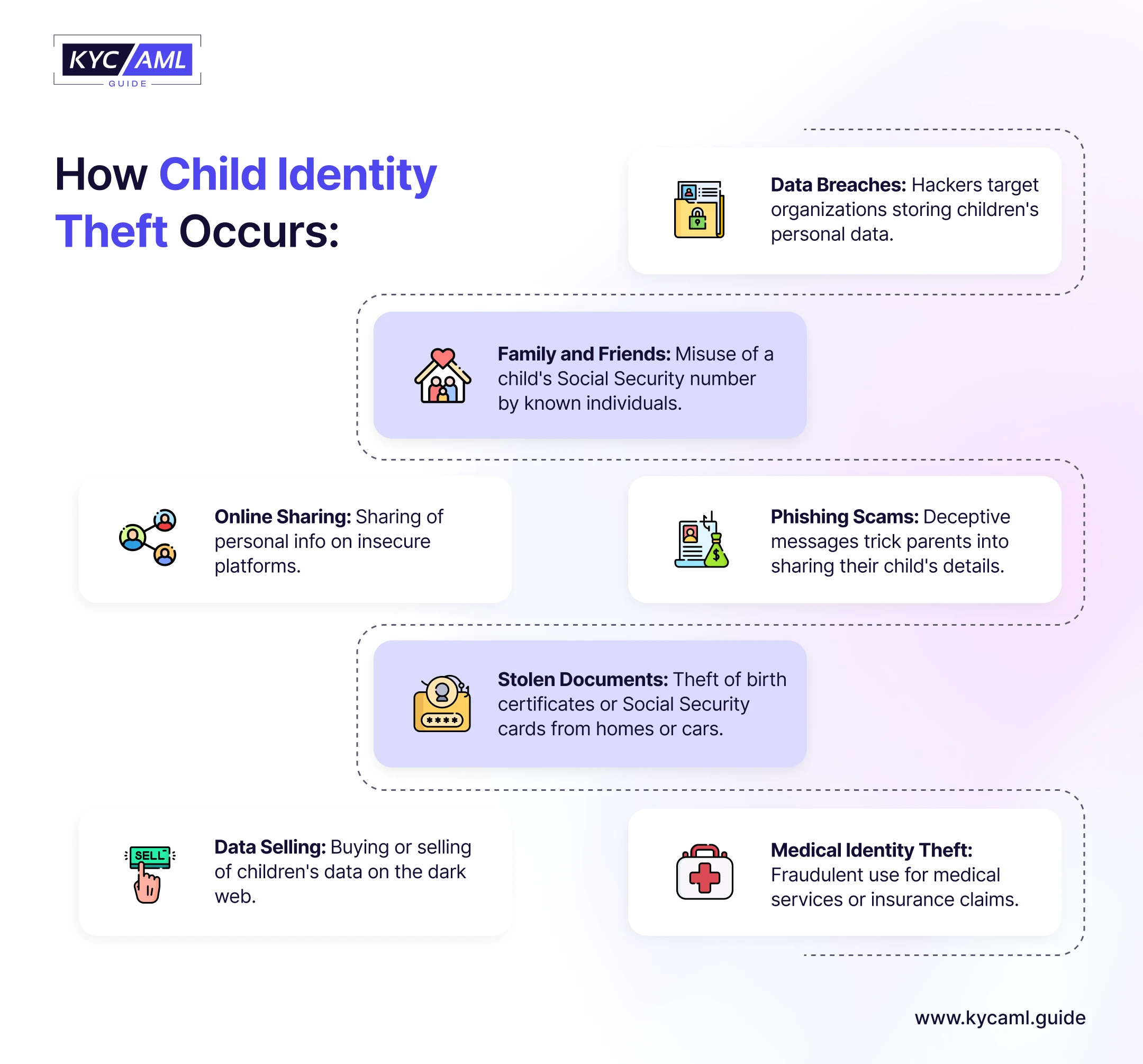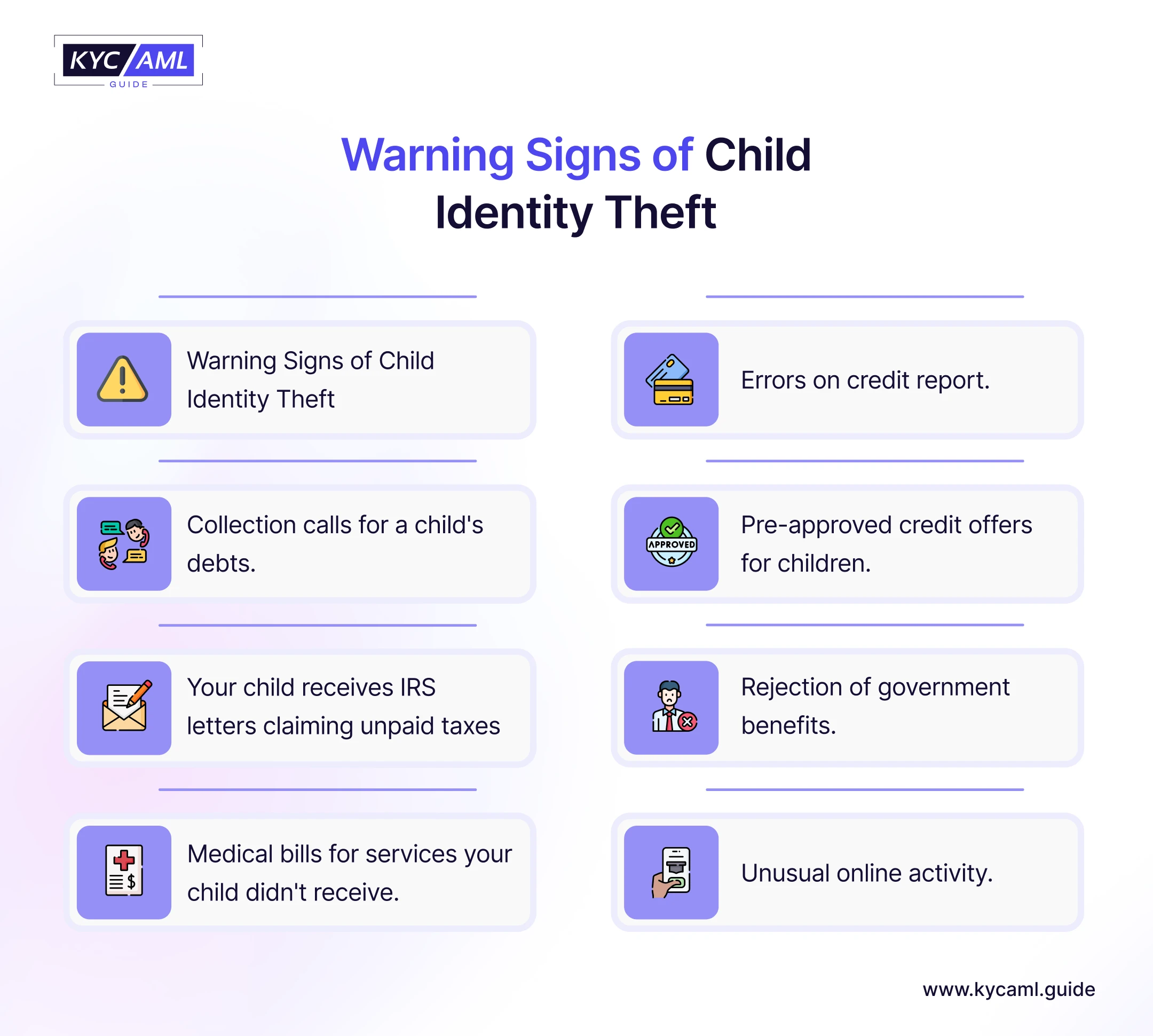What is Child Identity Theft?
Child identity theft is when a minor’s personal information is used to create fake accounts. They are then used for illegal activities by criminals. It usually remains undetected for years as children don’t have credit histories, credit scores, or bank accounts compared to adults. It comes to light when children apply for their first student loan application or first credit card and it gets rejected. Almost 1 million children become victims of identity theft each year. According to the non-profit Identity Theft Resource Center (ITRC), the number will keep increasing in the coming years.
Child Identity Theft: How it Happens?
Child identity theft can happen in various ways as parents usually don’t monitor their child’s personal information. Some of the ways are

The first way to protect your child from identity theft is to understand how it happens
- Firstly, identity thieves stole personal information such as social security number, date of birth, and email address.
- Next, they use this information to open bogus bank accounts, apply for credit cards, take out loans, rent a house, commit fraud, etc. This can be avoided if companies use identity verification methods like document verification and age verification to verify the age of the person getting the services.
- After getting all the benefits, the scammer vanishes without paying the debt. It gets detected when a child applies for a credit card or a student loan.
Ways to Protect Your Child From Identity Theft
Monitor Personal Information:
Your child’s personal information is compromised if you get emails for tax or credit history on their behalf. Some red flags that indicate that a child has become a victim of identity theft are given below. If you find any illegal activity on behalf of your child report it immediately to identitytheft.gov. Also, check with three credit reporting bureaus to see if your child has any credit history. Suppose they have then immediately requested a security freeze.

Educate About Online Safety:
In the age of social media, it is important to educate your children about online safety. Children love to share everything on social media and have limited knowledge about profile privacy settings. Children are not aware of the dangers of social media. So it is crucial to educate them to avoid sharing personal information on social media and to keep their profile private. Also, teach them about not opening links or websites as they are malware attacks and can spy on their personal information and use it illegally. According to a Javelin Study in 2021, children who use Twitter, Facebook, and Instagram are more likely to be exposed to data breaches.
When they have their first smartphone, warn them about answering unknown numbers. Tell them that texts and calls are not always from the people who they claim to be and they can be identity thieves. Also, check their phones and emails regularly to monitor suspicious activity and prevent child identity theft.
Secure Documents:
Identity thieves use this personal information to commit fraud. Keep your child’s important documents safe to prevent child identity theft. Secure important documents like their social security number and birth certificates in a safe place or locked cabinets so they don’t get stolen.
Use Privacy Settings:
The best place to get personal information for identity thieves is social media. Parents need to monitor their child online activities to save them. Parents need to check their children’s social media privacy settings and their accounts. They can enhance privacy by
- Making the social media accounts private
- Limiting the audience on social media
- Restricting people who can see their profile picture and posts
- Never disclosing personal information
- Disabling location for certain apps
- Not allowing all the apps to access the gallery and contacts
One common issue that is contributing to child identity theft problems is “Grandsharenting”. Sometimes grandparents share and reshare photos of their family on social media. According to the UK Bank of Barclays, parents oversharing will result in 7.4 million identity theft cases by 2030. This oversharing increases the risk of identity theft or the risk is even greater if you have tagged your location or any other personal information.
Monitor Credit Report:
It is a best practice to periodically check your child’s credit report even if the credit is frozen. If your child is under 16 there should be no credit report. In case you got one then it shows that your child has been a victim of child identity theft.
Freeze your Child’s Credit:
It is illegal for children under 16 to apply for credit cards or loans. So the best way is to freeze your child’s credit as it restricts access to credit reports. It prevents your child from becoming a victim of identity theft. This way scammers can not open accounts in their name.
However, like adults for children credit freeze cannot be done online and is more time-consuming. To request a credit freeze you need to provide certain documents such as
| Parents Documents | Child Documents |
| Government Issued ID
Birth certificate Utility bill or bank statement to provide proof of address Social security number |
Birth certificate
Social security number |
After gathering the required documents, print out the child freeze request form. Next mail the form with the hard copy of the documents to the three credit bureaus. The mailing addresses are given below
| Equifax | TransUnion | Experian |
| P.O. box 105788, Atlanta, GA 30348 | P.O. box 9554, Allen TX 75013 | P.O. box 380, Woodlyn PA 19094 |
The credit bureau will freeze the account within three days of receiving the application. According to the Consumer Financial Protection Bureau (CFPB), the credit bureau must send the mail confirming the freeze within the next 5 business days. This should also include information about how to lift the freeze.
The credit will remain frozen until the child lifts the freeze for a student loan or to apply for a credit card.
Dont Share your Child’s Social Security Number:
Never share your child’s social security number with anyone even with school, family friends, or volunteers. As in most cases, the perpetrator is a known person. If the school asks for a social security number then investigate properly by asking questions, why do they need it? etc. it is best to keep the social security number as safe as possible. Also, teach your children not to share it with anyone. The only entity that needs it is the IRS.
Wipe Devices before Recycling:
If you are giving away or selling your phones, computers, laptops, or tablets it is best to restore the device to wipe off everything. Wiping the memory prevents anyone from accessing images and documents on the device.
What To Do If Your Child’s Personal Information is Compromised?
If you find out that your child has been a victim of identity theft or the personal information is leaked follow these steps right away
- Report the relevant company where the fraud happened and request them to close the account.
- Report the three credit bureaus and request them to remove the fraudulent account from your child’s credit report.
- Review your child’s credit report.
- Freeze the child’s credit report.
- File a report of child identity theft to FTC at IdentityTheft.gov
- File a police report for identity theft.





